Axe
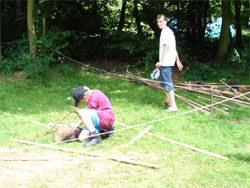
Introduction
An axe can be a very useful tool in camp. Note however that there are many different types of axe and they tend to be suitable for a limited range of work. In Scouting this should not present too much of a problem as we tend not to use the more 'specialist' types of axes.
Names of parts of an axe
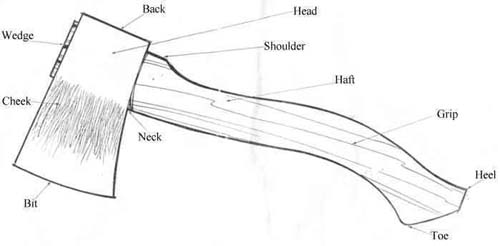
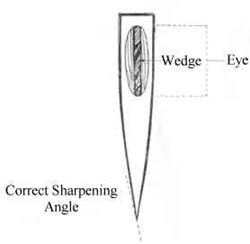
Sharpening an Axe
An axe with a blunt edge becomes no more than an inefficient hammer, and indeed a great deal more dangerous as you struggle to use it. Always keep your axe sharp. For large 'burrs' a file is probably your best bet. Make sure you use the file correctly though, it will only work in one direction, it works when pushed, not pulled.
To sharpen your axe prop the axehead between a log and a peg driven into the ground. Always try to sharpen inwards from the cutting edge (to avoid producing any burrs). First use a file or rough stone to remove any burrs and rucks. Then finish with a smoother stone, using a circular motion. Don't drag the stone off the cutting edge, push on to the blade.
Turn the axe over and repeat the process, circling in the opposite direction.
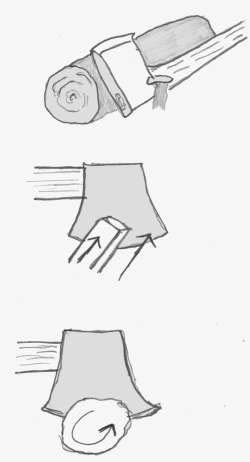
Chopping Areas
When chopping wood at camp, you will need to create a specific chopping area. Choose a site that is fairly close to the fire and clear of any obstructions (not only on the ground. Ensure there are no overhead obstructions that could catch your axe as you swing). Make a circle that is at least 2m (6 ft) in radius (or at least 3 axe lengths). Rope this area off and ensure it is clearly marked. Make sure that everyone knows where the chopping area is. No loose clothing should be taken into the area, and no one should enter the area without strong shoes or boots (and of course checking it is safe to enter).
Using an Axe
Most people with have a 'prime' hand and a natural swing. Always use the axe in a way that is comfortable to you, swinging in an arc that feels natural. Make sure you have a firm grip, and always swing AWAY from your body, hands, and legs. Ensure that if you miss your intended target and follow through, the axe will not strike you or anyone else. Never throw an axe on the ground, always sheath it or bury it in a log.
Making an Axe
First you will need to select the wood for your handle, any straight, knot-free hardwood will be suitable (ash and hickory are ideal). Cut two notches into the fluke of a buttress, spaced to the desired handle length. Hit along the side of the fluke close to the cuts. It will split away at their depth.
Next you will need to fit the head. Whittle the handle into shape with one end cut to fit the hole in the axehead. Make sure you cut a notch in this end that is going into the axe head and make a wedge to fit the notch. With the head in place, drive the wedge into the notch and then soak the axe in water overnight (this will tighten the head onto the handle as it soaks up the water). Always check your axehead for tightness before you use them.
Carrying an Axe
Carry an axe by holding it just under the head. Point the blade down or away from you to minimize the chance you will fall on top of the blade if you trip
Tree Felling
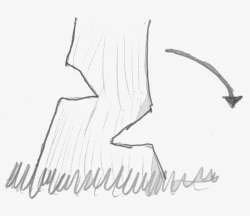
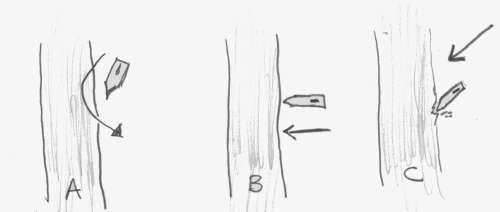
Before you do anything else, check overhead for dead branches which may fall and injure you, and for things like hornets nests. Clear the area around the tree of any undergrowth or branches that could deflect your blows. If the tree has a particularly large spread of roots or boles around the base you may want to construct a platform so that you can reach a thinner part of the trunk and save time and effort. Obviously if you do this make sure the platform is stable and you have a clear route of escape (in case something goes wrong!).
Cut from both sides of the tree. First you chop a notch out at an angle of about 45 degrees and then another on the opposite side at a lower level, on the side which you want the tree to fall.
Do not cut through more than half the tree before starting the other notch.
You must work at a height that is comfortable for you. Try to cut downwards at 45 degrees (you may need a horizontal cut occasionally to clear debris etc.).
A steady rhythm of blows will cut much more efficiently than fewer big blows. If you put too much effort behind the axe your aim will suffer, you will tire and then every swing becomes more dangerous. Always let the weight of the axe do the work.
Alternating the angle of the stroke will prevent the axe from jamming. Too steep an angle will cause the axe to glance off, end-on will make the axe jam (or simply be inefficient). Try to aim for a 45 degree angle.
Splitting Logs
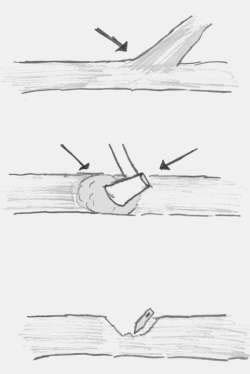
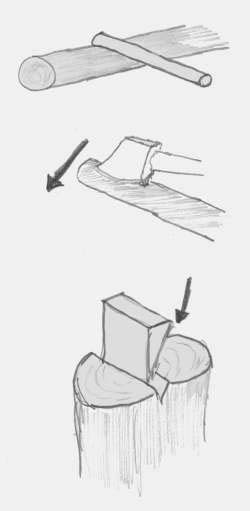
For a large log, as before, stand behind the log with your feet well apart. Swing down the cut the side away from you. Do not chop downwards. If you wish to split a smaller log, lay it against another log. Do not put your foot on it. There is an alternative to this though, hold the smaller log against the cutting edge and bring them both down together on to a larger log.
If in doubt, or if you have any difficulty, split larger logs with a wedge and a rock. Do not hold the wood upright in your hand and try to split with an axe.
When chopping branches from a large log, always stand on the side away from the axe. Always cut branches from the outside of the fork, not the inside.
Fitting an Axe with a Handle
If the head is loose you can soak the axe for a few hours in a bucket of water but this will only ever be a temporary fix (the wood will swell and the handle will be tight for a little while). Ideally you need to replace the handle or at least replace the wedge.
Saw off the old handle close to the axe head (Note: you should not just burn the handle off as this will cause the bit to lose its temper, note the above arrangements) and drill out the wood that is left in the axe head. You can punch the rest of the wood backward from the handle side and then clean inside the hole.
Get the new handle and pound it into the head. Make sure the handle passes out the other side by at least an inch. Also be sure that the new handle is correctly aligned.
Put some glue on a wedge and in the slit for the wedge in the end of the handle (you did make a slit didn't you?) and then drive in the wedge. You can now saw off the excess handle and wedge.
It would be a good idea to fix the wooden wedge in place with a steel wedge, placed diagonal to the wooden wedge.
Broken handles
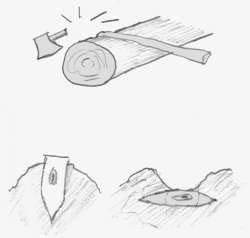
Using an axe takes a lot of practice and occasionally along the way handles get broken. This usually occurs when the head misses the target and the handle takes all the force from the blow. To remove a broken handle, the easiest way is to put it in a fire, burying as much as possible of the metal in the earth (to prevent it losing temper).
Never attempt to repair an axe handle.
Never use any axe that has a damaged or split handle.